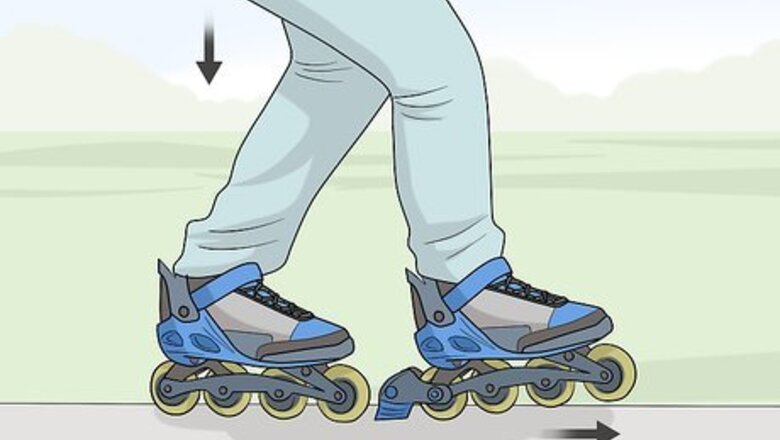
views
- Place 1 foot in front of you and bend the other leg. Then, slowly press your front foot’s heel brake to the ground, applying pressure until you stop.
- Slow down by skating onto grass, dirt, or gravel. Or, skate near a wall and extend your hands against it if you need to stop.
- Alternately, slow down with a plow or v-stop. Spread you legs over a shoulder-width apart and angle your toes inward.
Applying the Heel Brake
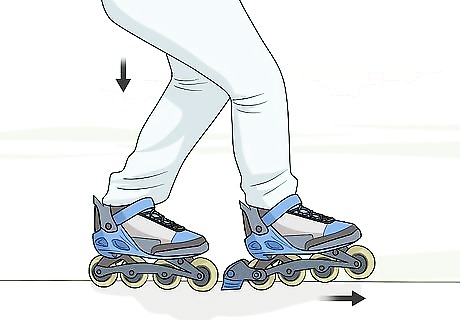
Extend 1 leg out in front of you and bend the other leg as if sitting down. The brakes on rollerblades are located at the back of the boots rather than in front like they are on roller skates. To stop with the brake, shift most of your weight to 1 leg and bend that knee slightly as if you’re beginning to sit down. As you do this, bring the opposite leg out in front of you, keeping your leg straight.Tip: If you feel unsteady placing more weight on one leg, try scissoring your feet back and forth a few times to get used to the sensation of shifting your weight while you’re skating.
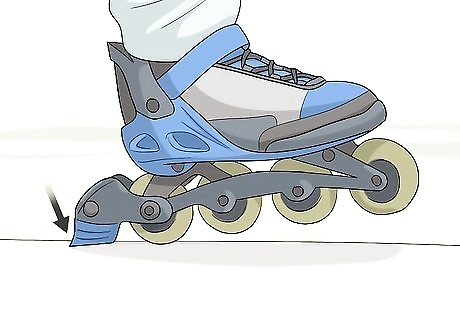
Press the heel brake against the ground with your front foot. Extend your foot forward more if needed and allow the heel brake to make contact with the ground. Then, apply firm pressure to stop quickly or gentle pressure to stop slowly. Practice braking while skating slowly until you become comfortable with the motion. Then, you can use the brake to stop when you are going fast.

Continue to apply pressure until you come to a complete stop. If you apply firm pressure, you will stop more quickly than if you apply light pressure. Keep pressing your heel against the ground until you come to a complete stop. An added bonus of using your brake is that it will make a squealing sound, which can alert people nearby of your presence and this may help to prevent a collision in some cases.
Using Beginner Stopping Techniques
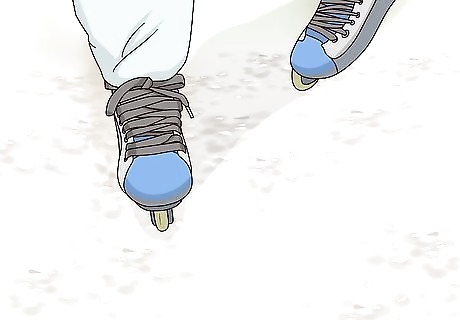
Skate onto grass, dirt, or gravel to gradually slow yourself down. If you are going very fast and haven’t gotten the hang of other stopping methods yet, look for a patch of grass, dirt, or gravel that you can skate onto. The rough texture will slow you down gradually until you come to a complete stop. This technique is known as “running out.” You can also use running out to slow down and return to the pavement once your speed is reduced to the desired level. An added benefit of skating onto grass is that it will hurt less if you lose control and fall than if you fall on concrete.
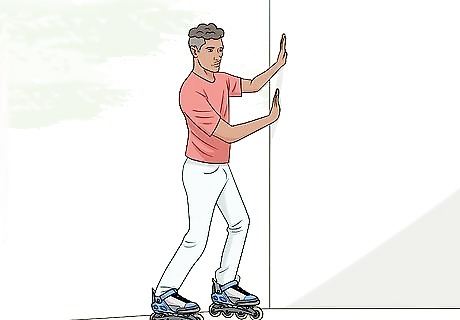
Straighten your arms out in front of you and skate towards a wall. Use your hands to absorb the impact and gently push yourself backwards when you hit the wall. Turn your head to the side to avoid smacking your face as well. This stop works for any speed, but be careful if you are going fast. You could also skate towards a railing or stairs to stop yourself if there’s no wall nearby. If you’re skating with a friend or family member, you could also skate towards them to slow your momentum. Just make sure that you warn them first, such as by saying, “Skating into you to slow down!”
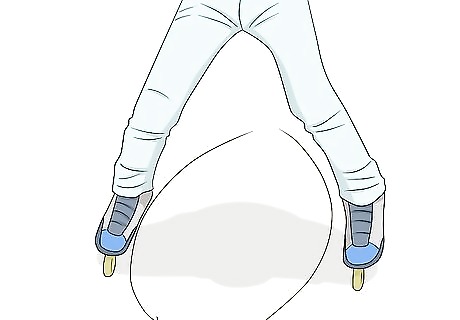
Use the plow stop or v-stop to slow yourself down gradually. Spread your legs out wider than shoulder-width apart as you skate and turn your toes in towards each other to stop. Brace yourself when you do this as slowing your momentum may cause you to fall forward. Your skates may also bang into each other. You can also use this technique if you are skating backwards, such as by turning your heels in toward each other.

Learn how to fall safely in case you're unable to stop. Falling safely will help you to prevent serious injuries, so be aware of how to do it. Remember to bend your knees if you’re about to fall and try to crash on your elbow or knee pads rather than trying to stop yourself with your hands, which could result in a broken wrist or skinned palm. Tip: If possible, try to fall on a patch of grass or sand. This will be less painful than falling on concrete.
Stopping with Intermediate Techniques
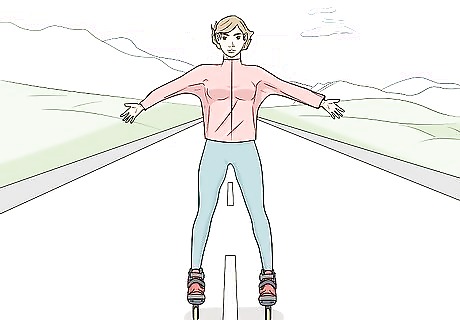
Spread out your arms and use the wind to slow your momentum. This technique is known as windbreaking and can be a good way to slow yourself down if you’re going too fast. You can windbreak and use another technique to stop yourself completely, or you can just gradually glide to a stop after slowing your momentum. This works best on a windy day and if you are wearing something that will catch the wind, such as a jacket. Don’t use this technique if you need to stop in a hurry.
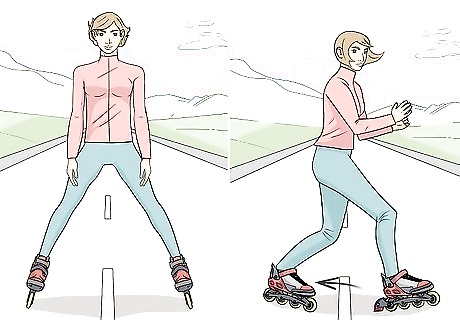
Widen your stance and spin around 180 degrees for a showy stop. While gliding, move your legs outwards so your skates are wider than shoulder-width. Keep your toes pointing forward. Then, rotate your upper body and hips to turn yourself 180 degrees in one direction. The spinning motion will slow your momentum and bring you to a complete stop. Practice this stopping technique while skating slowly at first. Then, try it going at higher speeds once you feel comfortable with the motion. Tip: If you’re going fast, lean forward slightly after you spin around. This will help to prevent you from falling backward.
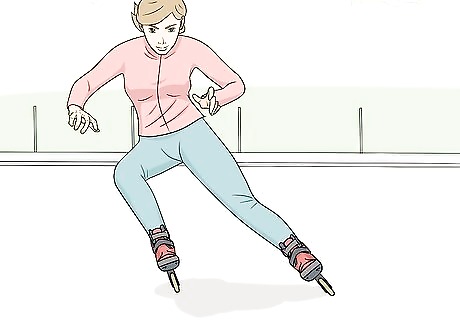
Try the slalom stop for a way to slow down and stop with flair. Turn to the left and then to the right very sharply. This will slow your forward momentum very quickly and bring you to a stop. This technique works well when you are moving at high speed and need to slow down or control your speed.
Trying More Advanced Stops
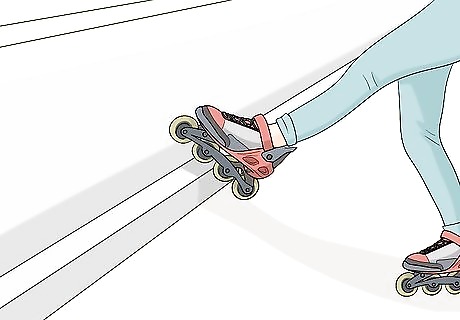
Attempt curb ramming for an immediate way to stop. Skate towards a curb or step and lift 1 skate up so that the middle of your wheels are even with the curb. Then, step or bang the bottom of your skate against the curb to stop yourself. Brace yourself for impact with the curb to avoid tripping or falling forward. Be aware that this can damage your skates if you do it too often, so reserve it for when you really need to stop in a hurry.

Do a T-stop for a fast way to brake. Drag one foot behind you with your toes turned out to the side. Ensure that the wheels of your back skate are perpendicular to the wheels of your front skate or to the direction you are traveling in. Then, apply downward pressure with your back foot to slow your momentum and bring you to a stop. A variation on this stopping technique is called the toe drag, which is when you only press the side of the front wheel against the ground to bring yourself to a stop. Warning: The T-stop and toe drag can damage your wheels, so it’s best not to use them too often.
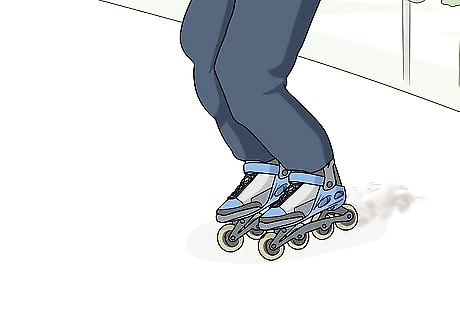
Use the hockey stop for a quick way to stop with a turn. This stopping technique is also known as a power slide. Make a very fast turn to the left or right while you’re traveling forward, and then slide sideways until you come to a complete stop. Keep your knees slightly bent and lean away from the direction you are moving. Stay as low as possible to improve your balance. This stop works well on relatively smooth surfaces, but takes practice to perfect. It is actually harder to do this stop when moving slowly as you almost have to jump into it.

Step forward or backward to stop yourself. Stepping stops are when you pick up your skates and take a few steps in the direction you are traveling without propelling yourself forward. Try lifting up your right foot for a few seconds and then place it back on the ground. Then, lift up your left skate for a few seconds and place it on the ground. Do this until you glide to a complete stop. You can use this technique to gradually stop while traveling forward or backward.

Lean back to stop using both brakes for the Wile E. Coyote method. This is an advanced technique for a very quick stop that might remind you of the cartoon character. While skating forward, lean back to apply pressure to both heel brakes at once. Brace yourself when you do this and be ready to take a few steps forward if you’re going very fast.














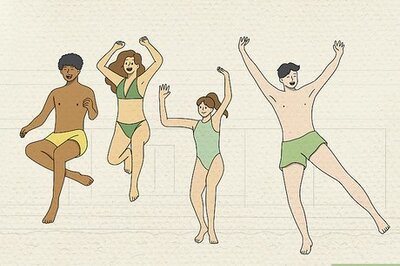
Comments
0 comment